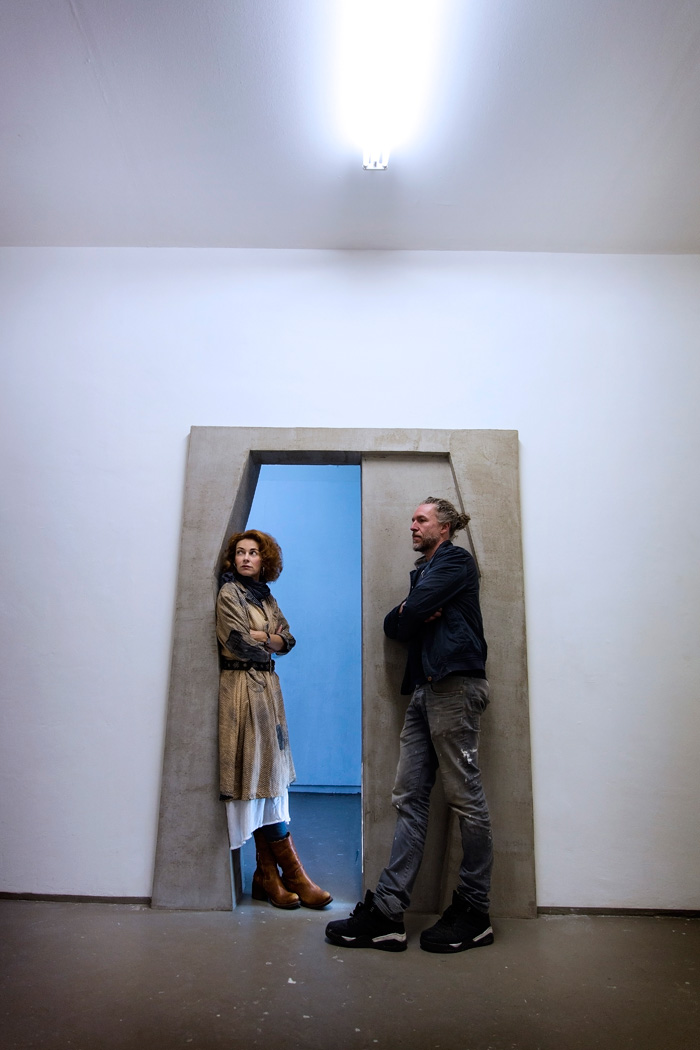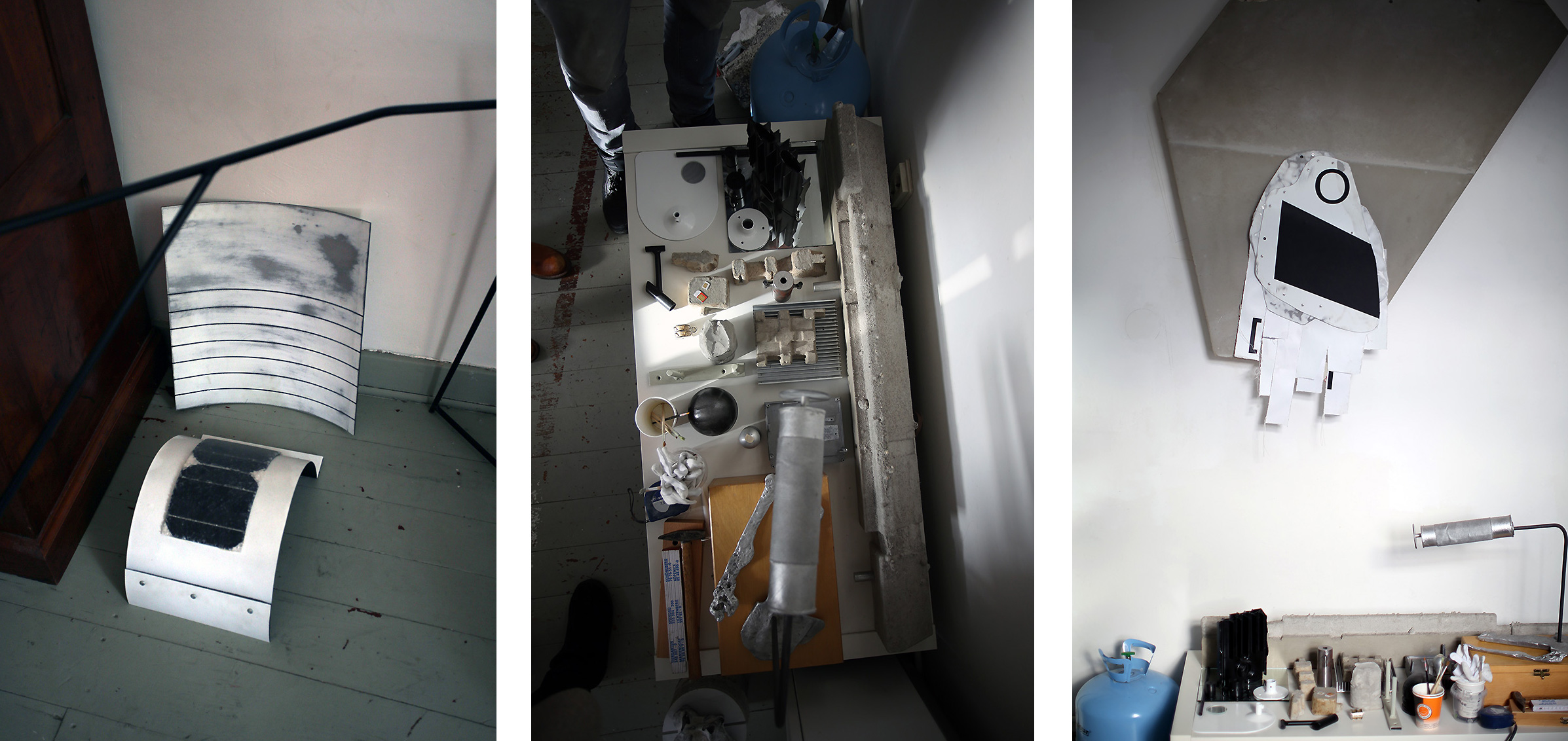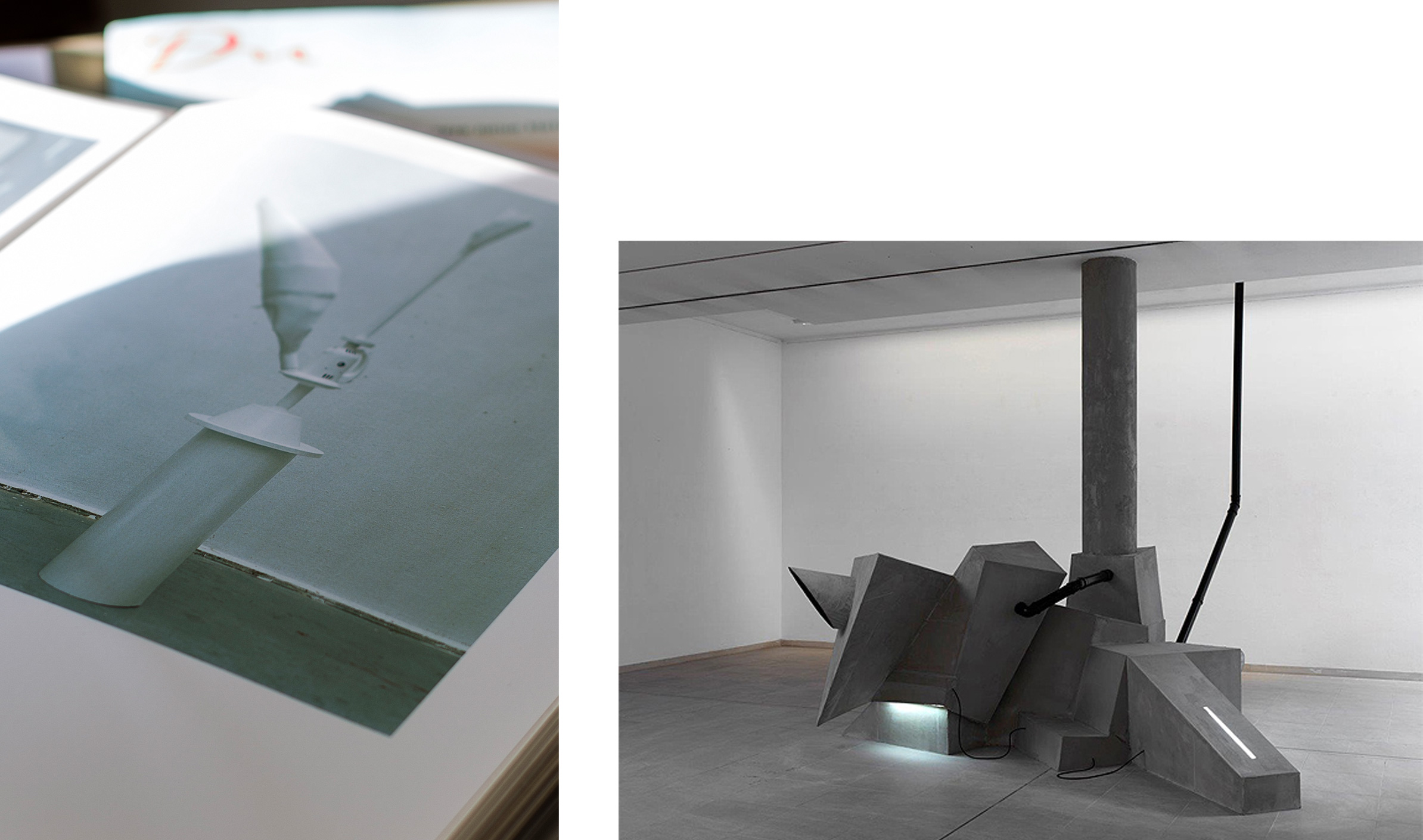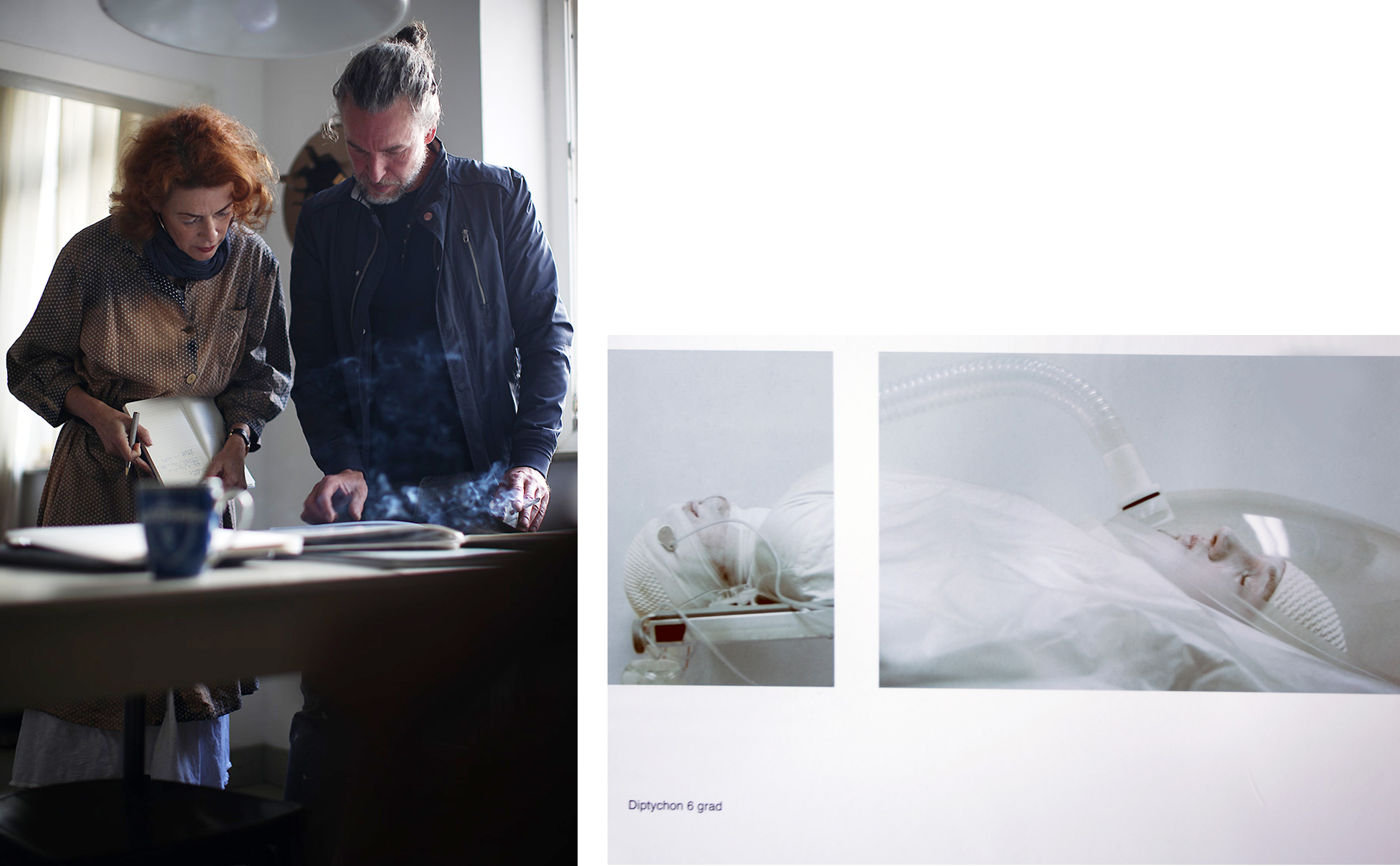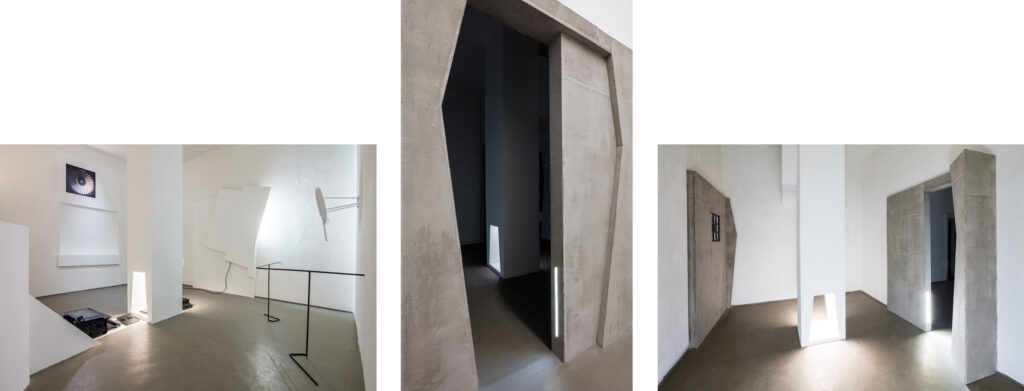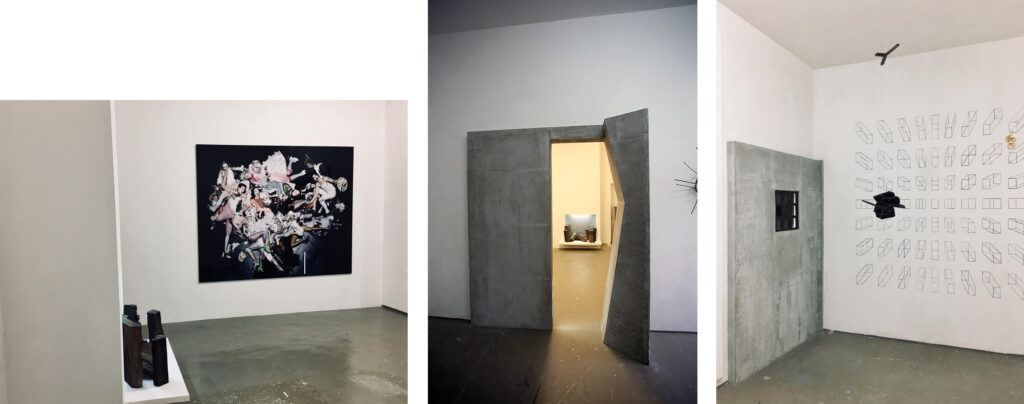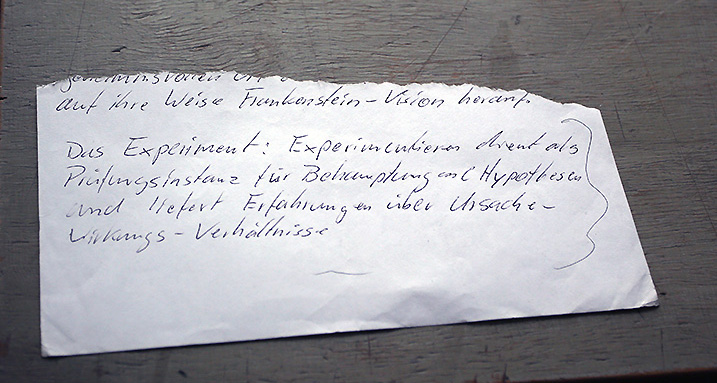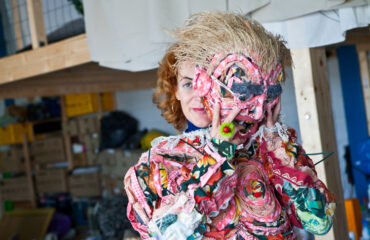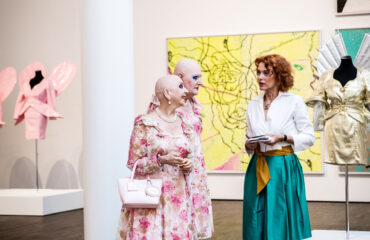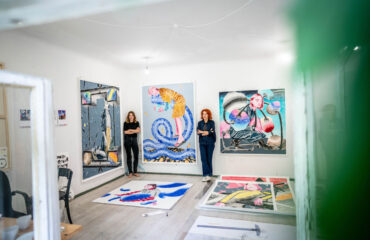Photos: Natascha Romboy, Thomas Woll
Düsseldorf, 28 November 2017. Today I am visiting the studio where the artist Thomas Woll lives. He is master student of Prof. Irmin Kamp at the Düsseldorf Academy. Considering Woll’s work moves between room installations, architecture and sculpture, so I am expecting a correspondingly large studio. Thus, I am quite excited entering the top-floor apartment. But it is surprisingly tiny. At first, the purist decoration and the thrown-together furniture make you think of a student flat, not a studio.
… Impressions of the studio and living-place
However, the objects carefully arranged on the low sideboard, and the additional sculptures on the wall and floor, make it possible to see that this is the home of the artist Thomas Woll.
Technoid, minimalist, futuristic: these are the typical adjectives to that describe his works. I want to use my visit to find out what this is all about.
… Finds and project sketches
First off, I’m interested which function in the role that his living and working spaces fulfil to him. “You could call it an ideas workshop. This is where I develop the concepts for my projects. Implementation happens later as part of a process at the exhibition site in question,” he explains to me. “Is this your collection and initial experimentation space?”, I ask while looking at the sideboard. “Yes. Collecting is very important. At the beginning of every idea there are objects I discover which seem to have some kind of technical implication, or actually have been part of a piece of technical equipment. Like this little blue tank for example, or the metal piece of scenery over there. At some point, these various discoveries interweave themselves with one another to form a sculptural framework, a kind of collage made from my finds,” says Woll, showing me drawings of his work.
“Are the sculptures first created with the room in mind as an entire installation, or just on their own?”, I’d like to know. “Both. However, they have a stronger impact in the room space,” replies Thomas Woll. As a comparison, he shows me drawings of a sculpture displayed on its own, as well as another one installed within a room. Astonishing! The isolated sculpture looks like a drawing of an innovative prototype in a scientific journal. The sculpture placed within the room appears to visualise a technical function that feeds on energetic connective components to become a spatial body.
Image 1: Print of his portfolio, Image 2: Exhibition “Bergischer Kunstpreis” at “Kunstmuseum Solingen”_Orbital Modul (2013)
His, Woll’s, artistic signature is always clearly recognisable. Firstly, it’s in the elements he uses. Technoid pieces of equipment are attached with pipes, tanks, cables, pieces of metal or sheet metal, and then often combined with bunker-esque architecture made from concrete. Secondly, it’s in the omnipresent implication of functionality that shifts into absurdity when you look closely. Nothing is working here. Nothing can actually work. A propeller is too big and lopsided; cables and pipes are leading to nowhere, inflatables are affixed in pointless places… The frequent use of neon tubes is also striking. I ask about it.
“The advantage of the neon tubes is that I can use them directly and indirectly. If I use them directly, I can define new shapes or reproduce elements of the room. Indirectly, I can use them for staging, both internally and externally. In addition, I can also use them to create that clinical, anti-septic light that I like using. It is this light that directly reminds you of experimental stations,” explains Woll.
Image 1: Ausstellung STRUCTANGLE X_Vom transphärischen Schweben (2014), Image 2: Ausstellung STRUCTANGLE X_Echokammer (2014), Image 3: Ausstellung RÄUME 1: ORBITALE HÜLLE_Kontrollpult (2011)
It is only now that I notice the video playing on the television in the room next door. It shows a beating heart.
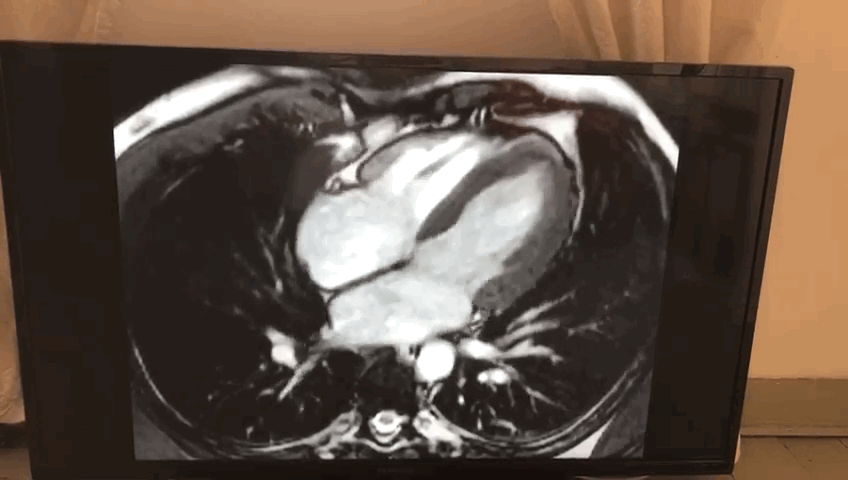
Thomas Woll’s beating heart in a state of virtual weightlessness (2003)
Thomas Woll follows my gaze and tells me about its background. “That is my heartbeat in a state of virtual weightlessness. In 2003, I spent four weeks taking part in an experiment in Cologne’s Centre for Aviation and Aerospace. The aim was to research the changes that the body undergoes when it is in a state of weightlessness. I spent two of the four weeks lying in a bed tilted to 6 degrees. Feet up, head down. This simulated the state of being weightless. Virtually, so to speak. Important questions in this regard were, for example, how the heart muscles and bone density change, or how eating and drinking habits alter. I spent these four weeks living in an isolated underground area with a total of ten test subjects. Cut off from the outside world, surrounded by technical equipment. This experience had an incredible impact on me. Science, space, septic atmospheres: these are the topics I have really been involved with since that period.” He shows me photos depicting him hooked up to tubes during one of the medical tests. It sends a shiver down my spine. The sensitivity of the human energy system, the dependence on technical equipment, the antiseptic atmosphere in the surgical areas of clinics: the photos display all this.
Image 1: Viewing the portfolio, image 2: Photos of Thomas Woll in the Centre for Aerospace in Cologne
It is now possible to draw clear parallels to his work. The cool, futuristic atmospheres of the rooms, the technical equipment, light and shade, cables and tubes, the obscure functional systems: everything can be ascribed to this ultimate experience.
The constructivist form of his architectural objects, in particular, evokes the concepts of the Eastern and Western avant-garde of the early twentieth century. In this regard, the absolute faith in machines as representatives of technology, speed and progress, among other things, found expression in this language of form. “Could this possibly lead to a connection?” I want to know now. “Absolutely. Even today’s society is shaped by an unconditional belief in functionality and technical progress. Our life processes are coded, and increasingly dominated by technology. The communication possibilities open to us lead us to believe that we can move towards each other at breakneck speed, overcoming time and place. But this is merely a virtual world. In the real world, we are steadily moving away from each other. In my art I try to give the virtual world a form so that we can expose the possible conditions of a world of this kind,” he answered.
This becomes abundantly clear in his current exhibition in Oberkassel. We travel together to the “Raum für Kunst” art space, where Thomas Woll is once again exhibiting his work. This time, this is within the group exhibition initiated by Rainer Junghanns: DAS GROSSE FRESSEN _ HEIMAT _ AUF WIEDERSEHEN.
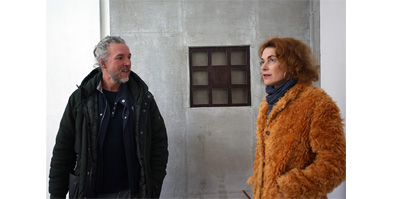
Inside the „Raum für Kunst“ Exhibition DAS GROSSE FRESSEN _ HEIMAT _ AUF WIEDERSEHEN (2017)
I’m eager to see what the space will look like after its latest transformation. Nothing is as it was, with the exception of two massive concrete elements. Walls that previously enclosed window apertures have been removed. A pillar which seemed to support the space has vanished. A walled-up shelf has been transformed into a kind of open fireplace. If you regularly visit exhibitions here, you’ll soon lose your sense of direction. The huge concrete element in the passage to the second room is an unmistakable reminder of an access door inside a spaceship. You can almost hear a gentle “whoosh” from the closing. But again, here the form of the construction prevents it taking on the function the viewer expects. “We were just talking about our quest to overcome space and time. Does your attempt to overcome space consist of taking it apart and reassembling it?”, I try to interpret his architectures.
Image 1: ECHOKAMMER, Image 2 – 3: ECHOS (Transformation von Echokammer in den Raum 2)
Image 1 – 3: Ausstellung DAS GROSSE FRESSEN _ HEIMAT _ AUF WIEDERSEHEN (2017)
“You could say that. Overcoming, perhaps in the sense that I question the conditions and functions of a room just as much as the objects of our daily lives, our environment in general. Just as I experiment with each of my finds, I also experiment with space. Deconstruction and construction are very important in the process of my work. Only when my objects interact with the space to create a new whole, both in terms of form and content, I can be happy,” concluded Woll.
As if to prove it, he smiles impishly and slides a scrap of paper over to me with the definition of the word experiment written on it.
How about coming to a conclusion on this basis?
Thomas Woll asserted that today’s society is shaped by an unconditional belief in functionality. The next step is to use his art to prove this hypothesis. And he does. What happens when we look at his art? We have a brief look around the room, and glance at the supposed equipment. Even though there might be quite a few puzzling elements here, we are sure in our belief that technology, progress and the future are being focused on, and that functioning systems are being presented. So much for the effect. And now to the question of the cause. How and why is this desired effect achieved?
It simply seems to be the application of a vocabulary that we know from his technoid context and which satisfies our idea of functionality, perfection and the future. Ironically, Thomas Woll uses analogue items from the past to lend form to his modern-day installations of a virtual, future world. A world that makes us question technical progress. A world in which nothing is as it seems. A world in which the overcoming of space and time proves to be a fiction …
More Information
… about the artist: http://www.tzrgalerie.de/woll.html
… about the „Raum für Kunst“: http://www.raumfuerkunst.org/
… about his participations in urban spaces:
_ Stein mit Vollausstattung in Dortmund: http://www.steinmitvollausstattung.de
_ 10 qm in Köln: http://www.10qm.de
